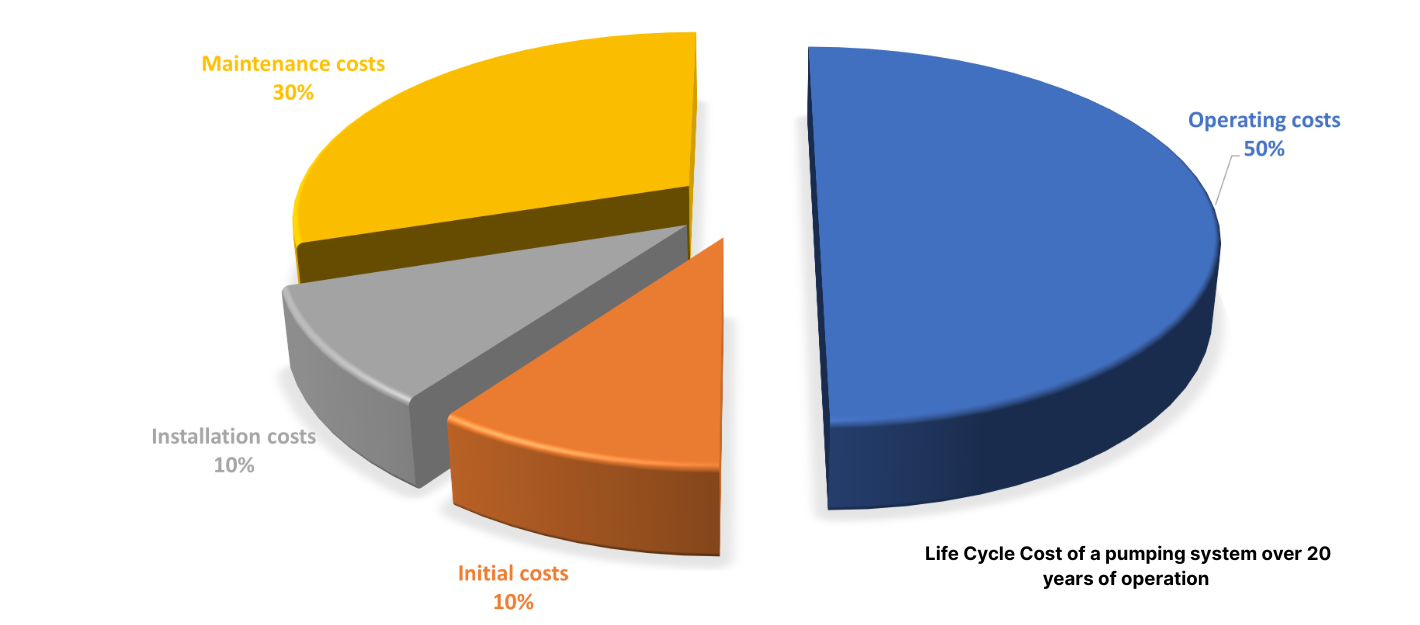Mobile pump systems are often treated as temporary tools: brought in, set up quickly, and expected to do the job. But without careful planning, these systems can become a major drain on fuel and maintenance budgets.

Here are five practical ways to reduce the operating costs of diesel-driven mobile pumps
1. Operate Close to the Pump’s Best Efficiency Point (BEP)
Running a pump near its Best Efficiency Point (BEP) reduces fuel use and mechanical stress. Selecting a pump based on its performance curve for your required duty point pays off quickly.
Selecting a centrifugal pump on BEP will also have a positive impact on the life span of the pump and reduces maintenance costs.
Example:
Duty point: 350 m³/h at 28 mwc
- BA150E D285: Runs at 1900 rpm, 80% efficiency → 33 kW → 9 L/hr
- BA180E D328: Runs at 1600 rpm, 68% efficiency → 39 kW → 10.5 L/hr
The BA150E uses 1.5 L less fuel per hour. Over time, that adds up, and it also means lower wear and fewer repairs.
Key point: Always review the pump curve and select equipment close to BEP
*Performance curve BA150E D285

2. Load the Engine Correctly
Engine fuel efficiency varies based on how much load it's under. Lightly loaded engines burn more fuel per kWh and can create regeneration issues with particulate filters.
Example:
- At 1900 rpm and 170 Nm torque, a diesel engine may consume ~216 g/kWh
- Reduce to 1500 rpm and 108 Nm torque → ~240 g/kWh
This change results in >10% higher fuel use.
Better solution: Use a smaller pump set working closer to full load. This ensures better fuel economy and more effective emissions control
* Example of a Brake Specific Fuel Consumption (BSFC) diagram.

3. Select the Right Pipe Diameter
Pipe friction adds head pressure. Higher pressure increases power demand and fuel use. A properly sized pipe can reduce fuel use by up to 3 L/hr. Use manufacturer tools or head calculators to compare options.
Example:
Flow: 350 m³/h over 150 m, 7 m elevation
- 6-inch pipe: Requires 27 mwc → higher speed, more fuel
- 8-inch pipe: Requires only 12 mwc → allows smaller pump, less fuel
4. Use Automatic Start/Stop Controls
Most mobile pumps don’t need to run 24/7. Automatic start/stop systems (based on float switches or pressure transducers) allow the pump to run only when needed. Install the float switches at high/low levels, activate AUTO mode, and let the pump handle the rest. This reduces both fuel consumption and service intervals significantly.
Example:
A sewage bypass pump running 24 hrs/day may use ~250 L fuel/day. With automatic control, it may only need 4–6 hrs/day, using 40–50 L.
5. Extend Service Intervals with Technology
Frequent servicing costs time and money. Newer pumps with extended maintenance features (e.g., BBA Pumps DriveOn® technology) allow up to 1500-hour intervals. That is 3x longer than the 500-hour intervals that are standard on most portable auto-prime vacuum or piston pumps.
Example over 30,000 hours:
- Standard pump: 60 oil changes
- Extended-service pump: 20 oil changes
Savings include: - 40 fewer oil changes
- 25% less oil used
- Fewer filter replacements
- Reduced labor and downtime
Quick math: If a typical oil service costs ~$950, that’s $20,000 in potential savings.

Final Note: Efficiency Cuts Emissions Too
Saving fuel not only reduces costs, it lowers environmental impact. A diesel engine running 30,000 hours can consume over 200,000 litres of fuel. Even a 10% reduction saves 20,000 litres and significantly cuts CO₂ emissions.
Summary: 5 Ways to Cut Pump Operating Costs
| Tip | Benefit |
| Run near BEP | Lower fuel use, less wear |
| load engine properly | Better fuel economy |
| Optimize pipe diameter | less friction, lower pressure |
| use auto start/stop | Avoid necessary runtime |
| Extend Service Intervals | Cut maintenance cost and downtime |
About BBA Pumps and Prime Fluid Management:
The cost-saving principles discussed here align with the efficient design of BBA Pumps, the pump supplier known for its focus on fuel efficiency and low maintenance. Prime Fluid Management, the exclusive distributor of BBA Pumps in New Zealand, provides local access to these high-performance systems, helping contractors in New Zealand reduce operating costs and environmental impact while ensuring reliable pump solutions for projects across various sectors.
Need help selecting the right pump or setup?
Need help selecting the right pump or setup? Contact our team, we can review your duty points and suggest the most efficient solution. Or call us on 0800 482 747/ Email us at: info@primefluid.co.nz


